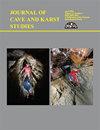冰川火山洞穴的形态动力学--美国华盛顿州雷尼尔山
IF 0.5
4区 地球科学
Q4 GEOSCIENCES, MULTIDISCIPLINARY
引用次数: 0
摘要
美国华盛顿州雷尼尔山的双峰火山口拥有世界上已知最大的冰川火山洞穴,海拔 4382 米,是美国海拔最高的洞穴。这些洞穴是由火山气体和大气平流在冰川与岩石交界处的冰层中形成的。然而,人们对离散洞穴的形成和演化过程仍然知之甚少。1970-1973年和1997-1998年对西陨石坑和东陨石坑洞穴系统的调查记录了洞穴通道形态。2014-2017年的实地考察全面调查了雷尼尔山顶洞穴,并进行了热成像和温度监测。洞穴发生了显著变化。在东陨石坑,有记录的洞穴长度自1973年以来增加了近一倍,达到3593米,深度达144米,揭示了一个新的冰川下湖泊,现在几乎环绕东陨石坑。据报道,在增加的长度中,约 600 米的测绘通道可能是新形成的。在 47 年的观察中,洞穴的某些部分似乎在形态和位置上随着时间的推移而得以保留,而其他部分则更积极地消失或形成。保留下来的通道一般都是次水平通道,沿着弧形火山口轮廓线延伸,显示出较低的温度变化,并依赖于常年的火成岩活动或来自温暖基岩和沉积物底部的分布式热通量。瞬态通道是直径较小的树枝状通道,沿着冰岩界面的斜坡向入口区延伸,与环形火山口通道相向。这些通道在温度和气流方面的变化也较大,并受到季节性天气和机械塌陷的影响,这可能是造成瞬变的原因。还需要进行更多的研究,以确认保持通道和形成瞬态通道的机制。本文章由计算机程序翻译,如有差异,请以英文原文为准。
Morphodynamics of glaciovolcanic caves—Mount Rainier, Washington, USA
The twin summit craters of Mount Rainier, Washington, USA host the largest known glaciovolcanic caves in the world and at 4382 m, the highest elevation caves in the USA. The caves are formed in ice at the glacier-rock interface by volcanogenic gases and atmospheric advection. However, the way in which discrete caves are formed and evolve remains poorly understood. Surveys of the cave systems in 1970−1973 and 1997−1998 in both the West and East Craters documented cave passage morphology. Field expeditions from 2014−2017 comprehensively surveyed the Rainier summit caves and undertook thermal imaging and temperature monitoring. Significant changes had occurred. In the East Crater, documented cave length has nearly doubled since 1973 to 3593 m of passage spanning 144 m of depth, revealing a new subglacial lake, and now nearly circumnavigating the East Crater. Of the reported increase in length, some 600 m of the mapped passage is possibly newly formed. Across 47 years of observation, certain sections of the cave appear to be preserved in form and position through time, while others are more actively being lost or forming. Conserved passages are generally sub-horizontal, passages following the curvilinear crater contours, show low temperature variability, and are dependent on perennial fumarolic activity or distributed heat flux emanating from warm bedrock and sediment floors. Transient passages are smaller diameter dendritic passages following the slope of the ice-rock interface towards entrance zones and normal to the circum-crater passage. They also show higher variability in temperature and airflow and are subject to seasonal weather and mechanical collapse, which may contribute to transience. Additional research is required to confirm the mechanisms maintaining conserved passages and formation of transient passages.
求助全文
通过发布文献求助,成功后即可免费获取论文全文。
去求助
来源期刊

Journal of Cave and Karst Studies
地学-地球科学综合
CiteScore
1.90
自引率
0.00%
发文量
6
审稿时长
>12 weeks
期刊介绍:
The Journal of Cave and Karst Studies is a multidisciplinary journal devoted to cave and karst research. The Journal is seeking original, unpublished manuscripts concerning the scientific study of caves or other karst features. Authors do not need to be members of the National Speleological Society, but preference is given to manuscripts of importance to North American speleology.
 求助内容:
求助内容: 应助结果提醒方式:
应助结果提醒方式:


